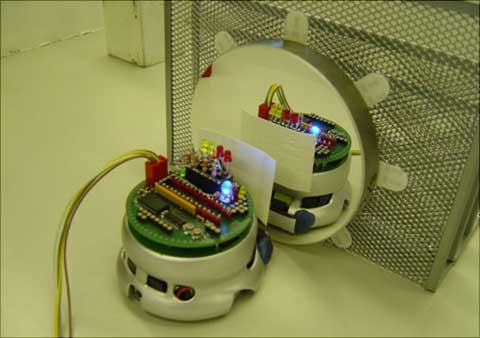2005 12 22
By Tracy Staedter | Discovery News
Thank you for the article Light Eye!
Comment from Light Eye: Re-member what happened in the "Terminator" when the machines became "self aware?"

The robot in this picture sees itself in a mirror and recognizes itself, a first for a so-called mirror image cognition robot. Picture: Courtesy of Junichi Takeno
Dec. 21, 2005— A new robot can recognize the difference between a mirror image of itself and another robot that looks just like it.
This so-called mirror image cognition is based on artificial nerve cell groups built into the robot's computer brain that give it the ability to recognize itself and acknowledge others.
The ground-breaking technology could eventually lead to robots able to express emotions.
Under development by Junichi Takeno and a team of researchers at Meiji University in Japan, the robot represents a big step toward developing self-aware robots and in understanding and modeling human self-consciousness.
"In humans, consciousness is basically a state in which the behavior of the self and another is understood," said Takeno.
Humans learn behavior during cognition and conversely learn to think while behaving, said Takeno.
To mimic this dynamic, a robot needs a common area in its neural network that is able to process information on both cognition and behavior.
Takeno and his colleagues built the robot with blue, red or green LEDs connected to artificial neurons in the region that light up when different information is being processed, based on the robot's behavior.
"The innovative part is the independent nodes in the hierarchical levels that can be linked and activated," said Thomas Bock of the Technical University of Munich in Germany.
For example, two red diodes illuminate when the robot is performing behavior it considers its own, two green bulbs light up when the robot acknowledges behavior being performed by the other.
One blue LED flashes when the robot is both recognizing behavior in another robot and imitating it.
Imitation, said Takeno, is an act that requires both seeing a behavior in another and instantly transferring it to oneself and is the best evidence of consciousness.
In one experiment, a robot representing the "self" was paired with an identical robot representing the "other."
When the self robot moved forward, stopped or backed up, the other robot did the same. The pattern of neurons firing and the subsequent flashes of blue light indicated that the self robot understood that the other robot was imitating its behavior.
In another experiment, the researchers placed the self robot in front of a mirror.
In this case, the self robot and the reflection (something it could interpret as another robot) moved forward and back at the same time. Although the blue lights fired, they did so less frequently than in other experiments.
In fact, 70 percent of the time, the robot understood that the mirror image was itself. Takeno's goal is to reach 100 percent in the coming year.
Article from: http://dsc.discovery.com/news/briefs/20051219/awarerobot_tec.html
